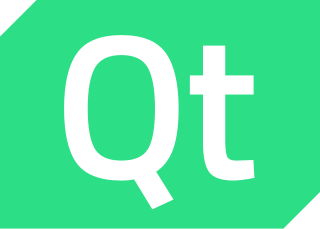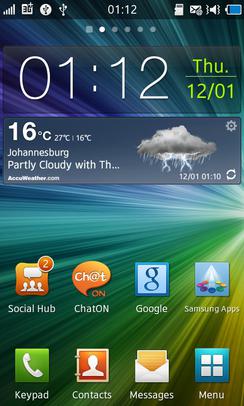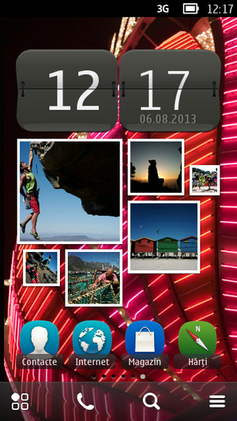Related Research Articles

Qt is a cross-platform application development framework for creating graphical user interfaces as well as cross-platform applications that run on various software and hardware platforms such as Linux, Windows, macOS, Android or embedded systems with little or no change in the underlying codebase while still being a native application with native capabilities and speed.

Palm OS is a discontinued mobile operating system initially developed by Palm, Inc., for personal digital assistants (PDAs) in 1996. Palm OS was designed for ease of use with a touchscreen-based graphical user interface. It was provided with a suite of basic applications for personal information management. Later versions of the OS were extended to support smartphones. The software appeared on the company's line of Palm devices while several other licensees have manufactured devices powered by Palm OS.
Java Platform, Micro Edition or Java ME is a computing platform for development and deployment of portable code for embedded and mobile devices. Java ME was formerly known as Java 2 Platform, Micro Edition or J2ME.
In computing, cross-platform software is computer software that is designed to work in several computing platforms. Some cross-platform software requires a separate build for each platform, but some can be directly run on any platform without special preparation, being written in an interpreted language or compiled to portable bytecode for which the interpreters or run-time packages are common or standard components of all supported platforms.
A computing platform, digital platform, or software platform is the infrastructure on which software is executed. While the individual components of a computing platform may be obfuscated under layers of abstraction, the summation of the required components comprise the computing platform.
The Connected Limited Device Configuration (CLDC) is a specification of a framework for Java ME applications describing the basic set of libraries and virtual-machine features that must be present in an implementation. The CLDC is combined with one or more profiles to give developers a platform for building applications on embedded devices with very limited resources such as pagers and mobile phones. The CLDC was developed under the Java Community Process as JSR 30 and JSR 139.
OpenMAX, often shortened as "OMX", is a non-proprietary and royalty-free cross-platform set of C-language programming interfaces. It provides abstractions for routines that are especially useful for processing of audio, video, and still images. It is intended for low power and embedded system devices that need to efficiently process large amounts of multimedia data in predictable ways, such as video codecs, graphics libraries, and other functions for video, image, audio, voice and speech.

Adobe AIR is a cross-platform runtime system currently developed by Harman International, in collaboration with Adobe Inc., for building desktop applications and mobile applications, programmed using Adobe Animate, ActionScript, and optionally Apache Flex. It was originally released in 2008. The runtime supports installable applications on Windows, macOS, and mobile operating systems, including Android, iOS, and BlackBerry Tablet OS.
Apache Cordova is a mobile application development framework created by Nitobi. Adobe Systems purchased Nitobi in 2011, rebranded it as PhoneGap, and later released an open-source version of the software called Apache Cordova. Apache Cordova enables software programmers to build hybrid web applications for mobile devices using CSS3, HTML5, and JavaScript, instead of relying on platform-specific APIs like those in Android, iOS, or Windows Phone. It enables the wrapping up of CSS, HTML, and JavaScript code depending on the platform of the device. It extends the features of HTML and JavaScript to work with the device. The resulting applications are hybrid, meaning that they are neither truly native mobile application nor purely Web-based. They are not native because all layout rendering is done via Web views instead of the platform's native UI framework. They are not Web apps because they are packaged as apps for distribution and have access to native device APIs. Mixing native and hybrid code snippets has been possible since version 1.9.

Bada was a mobile operating system developed by Samsung Electronics for devices such as mid- to high-end smartphones and tablet computers. The name is derived from "바다 (bada)", meaning "ocean" or "sea" in Korean. All phones running Bada were branded with the name Wave, unlike Samsung's Android devices which are branded as Galaxy.

Symbian was a mobile operating system (OS) and computing platform designed for smartphones. It was originally developed as a proprietary software OS for personal digital assistants in 1998 by the Symbian Ltd. consortium. Symbian OS is a descendant of Psion's EPOC, and was released exclusively on ARM processors, although an unreleased x86 port existed. Symbian was used by many major mobile phone brands, like Samsung, Motorola, Sony Ericsson, and above all by Nokia. It was also prevalent in Japan by brands including Fujitsu, Sharp and Mitsubishi. As a pioneer that established the smartphone industry, it was the most popular smartphone OS on a worldwide average until the end of 2010, at a time when smartphones were in limited use, when it was overtaken by iOS and Android. It was notably less popular in North America.

Firefox OS is a discontinued open-source operating system made for smartphones, tablet computers, smart TVs, and dongles designed by Mozilla and external contributors. It is based on the rendering engine of the Firefox web browser, Gecko, and on the Linux kernel. It was first commercially released in 2014.

Mono is a free and open-source software framework that aims to run software made for the .NET Framework on Linux and other OSes. Originally by Ximian which was acquired by Novell, it was later developed by Xamarin which was acquired by Microsoft. In August 2024, Microsoft transferred ownership of Mono to WineHQ.

ACCESS CO., LTD., founded in April 1979 and incorporated in February 1984 in Tokyo, Japan, by Arakawa Toru and Kamada Tomihisa, is a company providing a variety of software for connected and mobile devices, such as mobile phones, PDAs, video game consoles and set top boxes.

FireMonkey is a cross-platform GUI framework developed by Embarcadero Technologies for use in Delphi, C++Builder or Python, using Object Pascal, C++ or Python to build cross-platform applications for Windows, macOS, iOS, and Android. A third-party library, FMX Linux, enables the building of FireMonkey applications on Linux.

Sailfish OS is a paid Linux-based operating system based on free software, and open source projects such as Mer as well as including a closed source UI. The project is being developed by the Finnish company Jolla.
Crosswalk Project was an open-source web app runtime built with the latest releases of Chromium and Blink from Google. The project was founded by Intel's Open Source Technology Center in September 2013.
Flutter is an open-source UI software development kit created by Google. It can be used to develop cross platform applications from a single codebase for the web, Fuchsia, Android, iOS, Linux, macOS, and Windows. First described in 2015, Flutter was released in May 2017. Flutter is used internally by Google in apps such as Google Pay and Google Earth as well as other software developers including ByteDance and Alibaba.

Genode is a free and open-source software operating system (OS) framework consisting of a microkernel abstraction layer and a set of user space components. The framework is notable as one of the few open-source operating systems not derived from a proprietary OS, such as Unix. The characteristic design philosophy is that a small trusted computing base is of primary concern in a security-oriented OS.
References
- ↑ "Reference design targets Linux mobile phones". Linuxdevices.com\date= August 7, 2007. Archived from the original on March 3, 2009.
- ↑ "Access Linux Platform on Display at 3GSM". Engadget . February 12, 2007. Archived from the original on December 6, 2012.
- ↑ "Access Linux Platform at LinuxWorld SF". Palminfocenter.com. August 20, 2006. Archived from the original on February 9, 2014.
- ↑ "Access and PalmSource Announce the Access Linux Platform". Access/PalmSource press release . February 14, 2006. Archived from the original on September 1, 2013.
{{cite news}}: CS1 maint: bot: original URL status unknown (link) - ↑ "Access Releases Access Linux Platform PDK and SDK to Licensees and Developers". Access press release . February 12, 2007. Archived from the original on September 1, 2013.
{{cite web}}: CS1 maint: bot: original URL status unknown (link) - ↑ "Edelweiss". Edelweiss-mobile.com. Retrieved October 20, 2009.
- ↑ Kairer, Ryan (October 13, 2008). "Review of the Edelweiss mobile phone at Palm Infocenter". Palminfocenter.com. Archived from the original on October 4, 2013. Retrieved October 20, 2009.
- ↑ Keilhack, Kris (September 19, 2009). "ALP-powered Emblaze Edelweiss shelved in favor of Monolith?". PalmInfocenter.
- ↑ "The First Else (aka The Monolith)". Archived from the original on December 6, 2013.
- ↑ "The Monolith Project". Emblaze Mobile. Archived from the original on March 3, 2011. Retrieved October 20, 2009.
- ↑ Ricker, Thomas (June 30, 2010). "RIP: Emblaze kills First Else". Engadget. Archived from the original on December 3, 2013.
- ↑ "Access". Archived from the original on July 1, 2014. Retrieved August 10, 2014.
- ↑ "Zen of Palm". Accessdevnet.com. June 13, 2003. Archived from the original on March 10, 2013. Retrieved October 20, 2009.
- ↑ New Access Linux Platform Screenshots, Mobilelinuxinfo.com, August 9, 2007. Archived January 4, 2011, at the Wayback Machine
- ↑ "Framework aims to commercialize mobile Linux apps". Archived from the original on June 3, 2009., Linuxdevices.com, December 22, 2006.
- ↑ Access Releases Hiker Application Framework to Open Source Community, Access press release, December 12, 2006. Archived February 5, 2012, at the Wayback Machine